The Crystalline Structure of Thin Bismuth Layers Grown on Silicon (111) Substrates
Abstract
:1. Introduction
2. Growth and Experimental Details
3. Results and Discussion
3.1. X-ray Measurements
3.2. TEM Measurements
3.3. Raman Analysis
4. Conclusions
Author Contributions
Funding
Institutional Review Board Statement
Informed Consent Statement
Data Availability Statement
Conflicts of Interest
References
- Hoffman, C.A.; Meyer, J.R.; Bartoli, F.J.; Venere, A.D.; Yi, X.J.; Hou, C.L.; Wang, H.C.; Ketterson, J.B.; Wong, G.K. Semimetal-to-semiconductor transition in bismuth thin films. Phys. Rev. B 1993, 48, 11431–11434. [Google Scholar] [CrossRef] [PubMed]
- Rabin, O.; Lin, Y.M.; Dresselhaus, M.S. Anomalously high thermoelectric figure of merit in Bi1-x-Sbx nanowires by carrier pocket alignment. Appl. Phys. Lett. 2001, 79, 81–83. [Google Scholar] [CrossRef]
- Schindler, F.; Wang, Z.; Vergniory, M.G.; Cook, A.M.; Murani, A.; Sengupta, S.; Kasumov, A.Y.; Deblock, R.; Jeon, S.; Drozdov, I.; et al. Higher-order topology in bismuth. Nat. Phys. 2018, 14, 918–924. [Google Scholar] [CrossRef] [PubMed]
- Xiao, S.; Wei, D.; Jin, X. Bi(111) thin film with insulating interior but metallic surfaces. Phys. Rev. Lett. 2012, 109, 166805. [Google Scholar] [CrossRef] [PubMed] [Green Version]
- Gity, F.; Ansari, L.; Lanius, M.; Schüffelgen, P.; Mussler, G.; Grützmacher, D.; Greer, J.C. Reinventing solid state electronics: Harnessing quantum confinement in bismuth thin films. Appl. Phys. Lett. 2017, 110, 093111. [Google Scholar] [CrossRef] [Green Version]
- Pilidi, A.; Tzanis, A.; Helm, T.; Arfanis, M.; Falaras, P.; Speliotis, T. Nanometer-thick bismuth nanocrystal films for sensoric applications. ACS Appl. Nano Mater. 2020, 3, 9669–9678. [Google Scholar] [CrossRef]
- Zhong, W.; Zhao, Y.; Zhu, B.; Sha, J.; Walker, E.S.; Bank, S.; Chen, Y.; Akinwande, D.; Tao, L. Anisotropic thermoelectric effect and field-effect devices in epitaxial bismuthene on Si(111). Nanotechnology 2020, 31, 475202. [Google Scholar] [CrossRef]
- Huang, Y.; Zhu, C.; Zhang, S.; Hu, X.; Zhang, K.; Zhou, W.; Guo, S.; Xu, F.; Zeng, H. Ultrathin Bismuth Nanosheets for Stable Na-Ion Batteries: Clarification of Structure and Phase Transition by in Situ Observation. Nano Lett. 2019, 19, 1118–1123. [Google Scholar] [CrossRef]
- Lu, L.; Liang, Z.; Wu, L.; Chen, Y.X.; Song, Y.; Dhanabalan, S.C.; Ponraj, J.S.; Dong, B.; Xiang, Y.; Xing, F.; et al. Few-layer Bismuthene: Sonochemical Exfoliation, Nonlinear Optics and Applications for Ultrafast Photonics with Enhanced Stability. Laser Photonics Rev. 2018, 12, 1700221. [Google Scholar] [CrossRef]
- Kumari, L.; Lin, J.H.; Ma, Y.R. Laser oxidation and wide-band photoluminescence of thermal evaporated bismuth thin films. J. Phys. D Appl. Phys. 2008, 41, 025405. [Google Scholar] [CrossRef]
- Nevinskas, I.; Mockus, Z.; Juškėnas, R.; Norkus, R.; Selskis, A.; Norkus, E.; Krotkus, A. Terahertz photoconductivity spectra of electrodeposited thin bi films. Materials 2021, 14, 3150. [Google Scholar] [CrossRef] [PubMed]
- Yang, Z.; Wu, Z.; Lyu, Y.; Hao, J. Centimeter-scale growth of two-dimensional layered high-mobility bismuth films by pulsed laser deposition. InfoMat 2019, 1, 98–107. [Google Scholar] [CrossRef] [Green Version]
- Hattab, H.; Zubkov, E.; Bernhart, A.; Jnawali, G.; Bobisch, C.; Krenzer, B.; Acet, M.; Möller, R.; von Hoegen, M.H. Epitaxial Bi(111) films on Si(001): Strain state, surface morphology, and defect structure. Thin Solid Film. 2008, 516, 8227–8231. [Google Scholar] [CrossRef]
- Shen, K.; Hua, C.; Liang, Z.; Wang, Y.; Sun, H.; Hu, J.; Zhang, H.; Li, H.; Jiang, Z.; Huang, H.; et al. Epitaxial Growth of Free-Standing Bismuth Film on Graphene Embedded with Nontrivial Properties. ACS Appl. Electron. Mater. 2019, 1, 1817–1824. [Google Scholar] [CrossRef]
- Song, F.; Wells, J.W.; Jiang, Z.; Saxegaard, M.; Wahlström, E. Low-temperature growth of bismuth thin films with (111) facet on highly oriented pyrolytic graphite. ACS Appl. Mater. Interfaces 2015, 7, 8525–8532. [Google Scholar] [CrossRef]
- Nicolaï, L.; Mariot, J.M.; Djukic, U.; Wang, W.; Heckmann, O.; Richter, M.C.; Kanski, J.; Leandersson, M.; Balasubramanian, T.; Sadowski, J.; et al. Bi ultra-thin crystalline films on InAs(1 1 1)A and B substrates: A combined core-level and valence-band angle-resolved and dichroic photoemission study. New J. Phys. 2019, 21, 123012. [Google Scholar] [CrossRef] [Green Version]
- Reis, F.; Li, G.; Dudy, L.; Bauernfeind, M.; Glass, S.; Hanke, W.; Thomale, R.; Schäfer, J.; Claessen, R. Bismuthene on a SiC substrate: A candidate for a high-temperature quantum spin Hall material. Science 2017, 357, 287–290. [Google Scholar] [CrossRef] [Green Version]
- Walker, E.S.; Na, S.R.; Jung, D.; March, S.D.; Kim, J.S.; Trivedi, T.; Li, W.; Tao, L.; Lee, M.L.; Liechti, K.M.; et al. Large-Area Dry Transfer of Single-Crystalline Epitaxial Bismuth Thin Films. Nano Lett. 2016, 16, 6931–6938. [Google Scholar] [CrossRef]
- Devenson, J.; Norkus, R.; Juškėnas, R.; Krotkus, A. Terahertz emission from ultrathin bismuth layers. Opt. Lett. 2021, 46, 3681–3684. [Google Scholar] [CrossRef]
- Wada, M.; Murakami, S.; Freimuth, F.; Bihlmayer, G. Localized edge states in two-dimensional topological insulators: Ultrathin Bi films. Phys. Rev. B Condens. Matter Mater. Phys. 2011, 83, 121310. [Google Scholar] [CrossRef] [Green Version]
- Lu, Y.; Xu, W.; Zeng, M.; Yao, G.; Shen, L.; Yang, M.; Luo, Z.; Pan, F.; Wu, K.; Das, T.; et al. Topological properties determined by atomic buckling in self-assembled ultrathin Bi(110). Nano Lett. 2015, 15, 80–87. [Google Scholar] [CrossRef] [PubMed]
- Cucka, P.; Barrett, C.S. The crystal structure of Bi and of solid solutions of Pb, Sn, Sb and Te in Bi. Acta Crystallogr. 1962, 15, 865–872. [Google Scholar] [CrossRef] [Green Version]
- Hofmann, P. The surfaces of bismuth: Structural and electronic properties. Prog. Surf. Sci. 2006, 81, 191–245. [Google Scholar] [CrossRef]
- Kowalczyk, P.J.; Mahapatra, O.; McCarthy, D.N.; Kozlowski, W.; Klusek, Z.; Brown, S.A. STM and XPS investigations of bismuth islands on HOPG. Surf. Sci. 2011, 605, 659–667. [Google Scholar] [CrossRef]
- Wu, C.Y.; Han, J.C.; Sun, L.; Gong, H.R.; Liang, C.P. Effects of trigonal deformation on electronic structure and thermoelectric properties of bismuth. J. Phys. Condens. Matter 2018, 30, 285504. [Google Scholar] [CrossRef]
- Ushioda, R.; Shimura, M.; Nakatsuji, K.; Hirayama, H. Growth-rate dependence of the structural transition of bismuth islands on Si(111) substrates. Phys. Rev. Mater. 2022, 6, 043403. [Google Scholar] [CrossRef]
- Lu, D.; Luo, S.; Liu, S.; Yao, H.; Ren, X.; Zhou, W.; Tang, D.; Qi, X.; Zhong, J. Anomalous Temperature-Dependent Raman Scattering of Vapor-Deposited Two-Dimensional Bi Thin Films. J. Phys. Chem. C 2018, 122, 24459–24466. [Google Scholar] [CrossRef]
- Haro-Poniatowski, E.; Jouanne, M.; Morhange, J.F.; Kanehisa, M.; Serna, R.; Afonso, C.N. Size effects investigated by Raman spectroscopy in Bi nanocrystals. Phys. Rev. B 1999, 60, 10080–10085. [Google Scholar] [CrossRef] [Green Version]
- Ørjan, S. Handegård.; Kitajima, M.; Nagao, T. Laser-induced structural disordering and optical phase change in semimetal bismuth observed by Raman microscopy. Appl. Surf. Sci. 2019, 491, 675–681. [Google Scholar] [CrossRef]
- Depablos-Rivera, O.; Martínez, A.; Rodil, S.E. Interpretation of the Raman spectra of bismuth oxide thin films presenting different crystallographic phases. J. Alloys Compd. 2021, 853, 157245. [Google Scholar] [CrossRef]
- Onari, S.; Miura, M.; Matsuishi, K. Raman spectroscopic studies on bismuth nanoparticles prepared by laser ablation technique. Appl. Surf. Sci. 2002, 197–198, 615–618. [Google Scholar] [CrossRef]
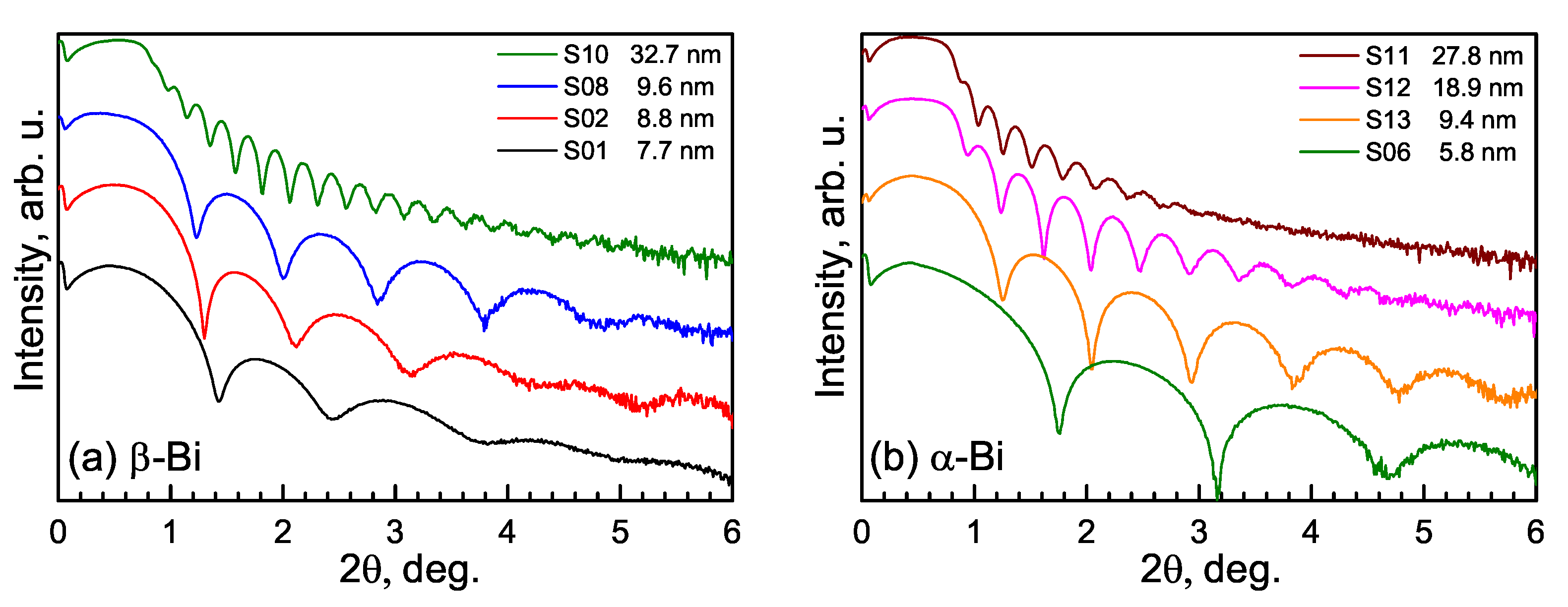
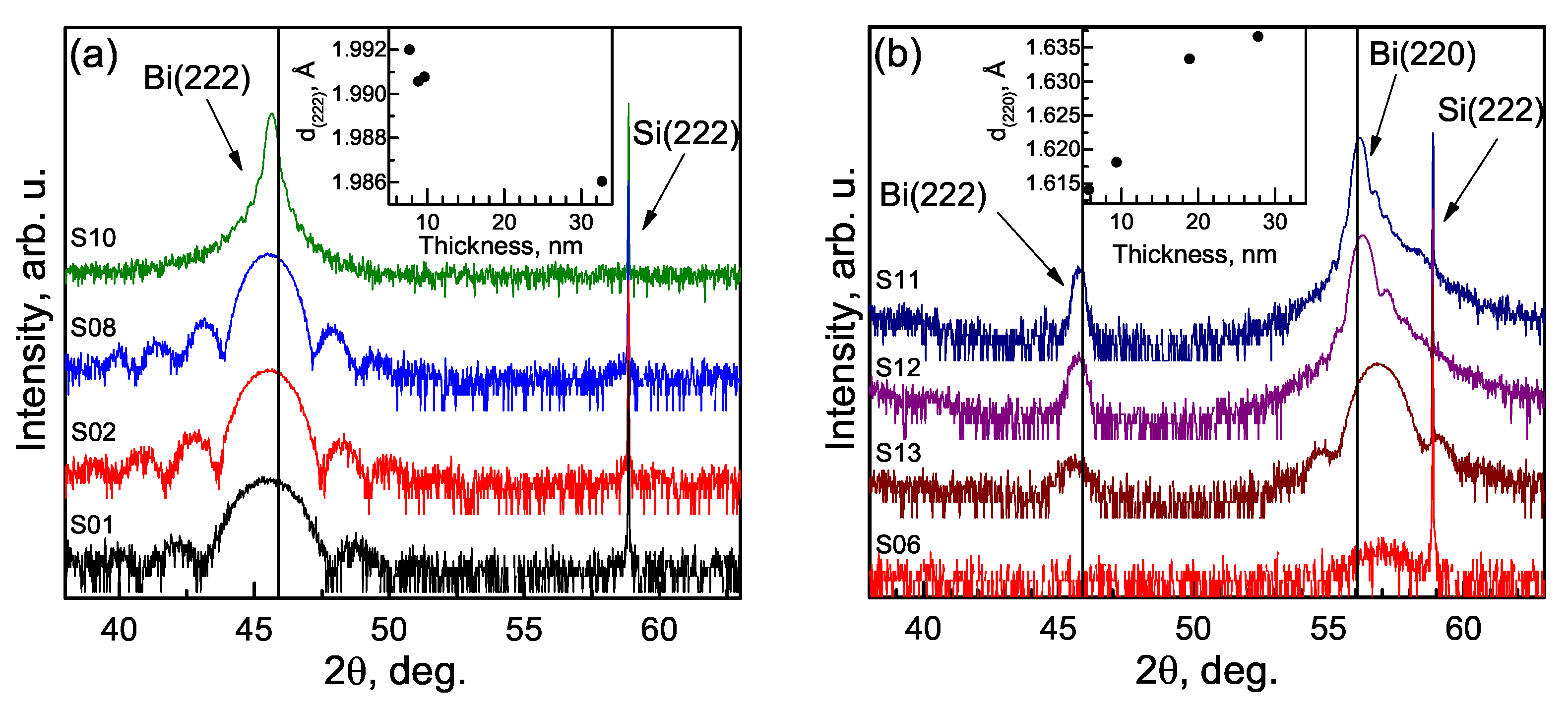
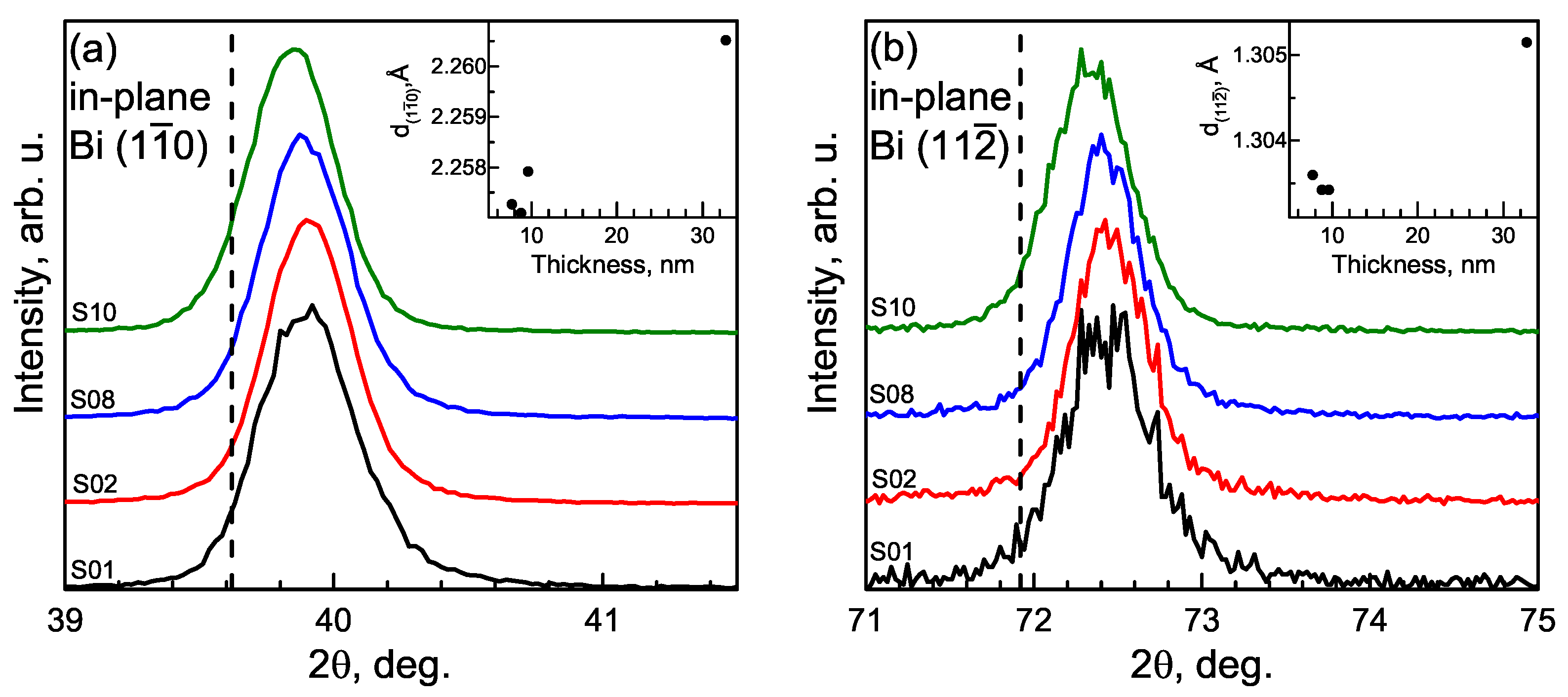
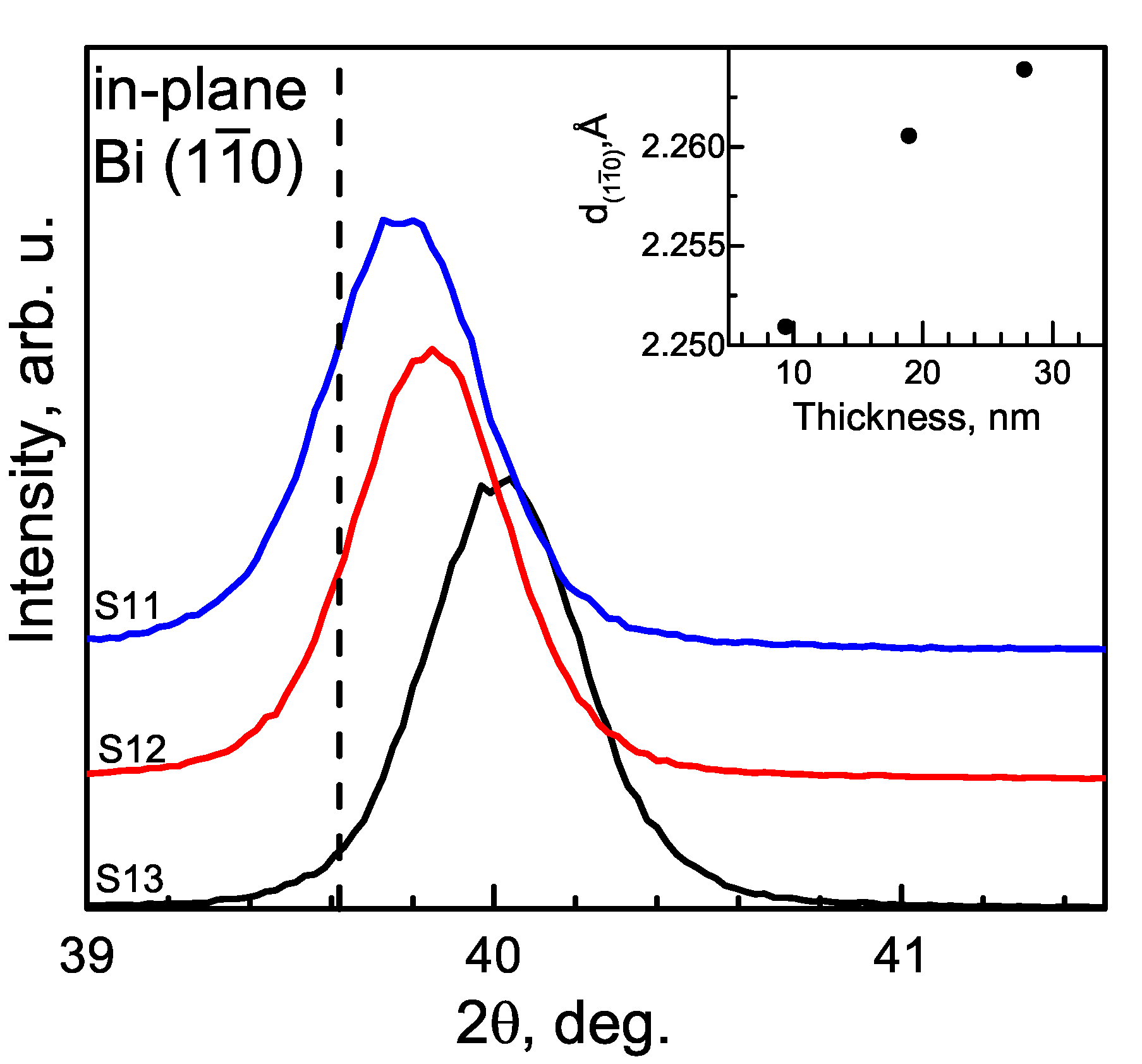

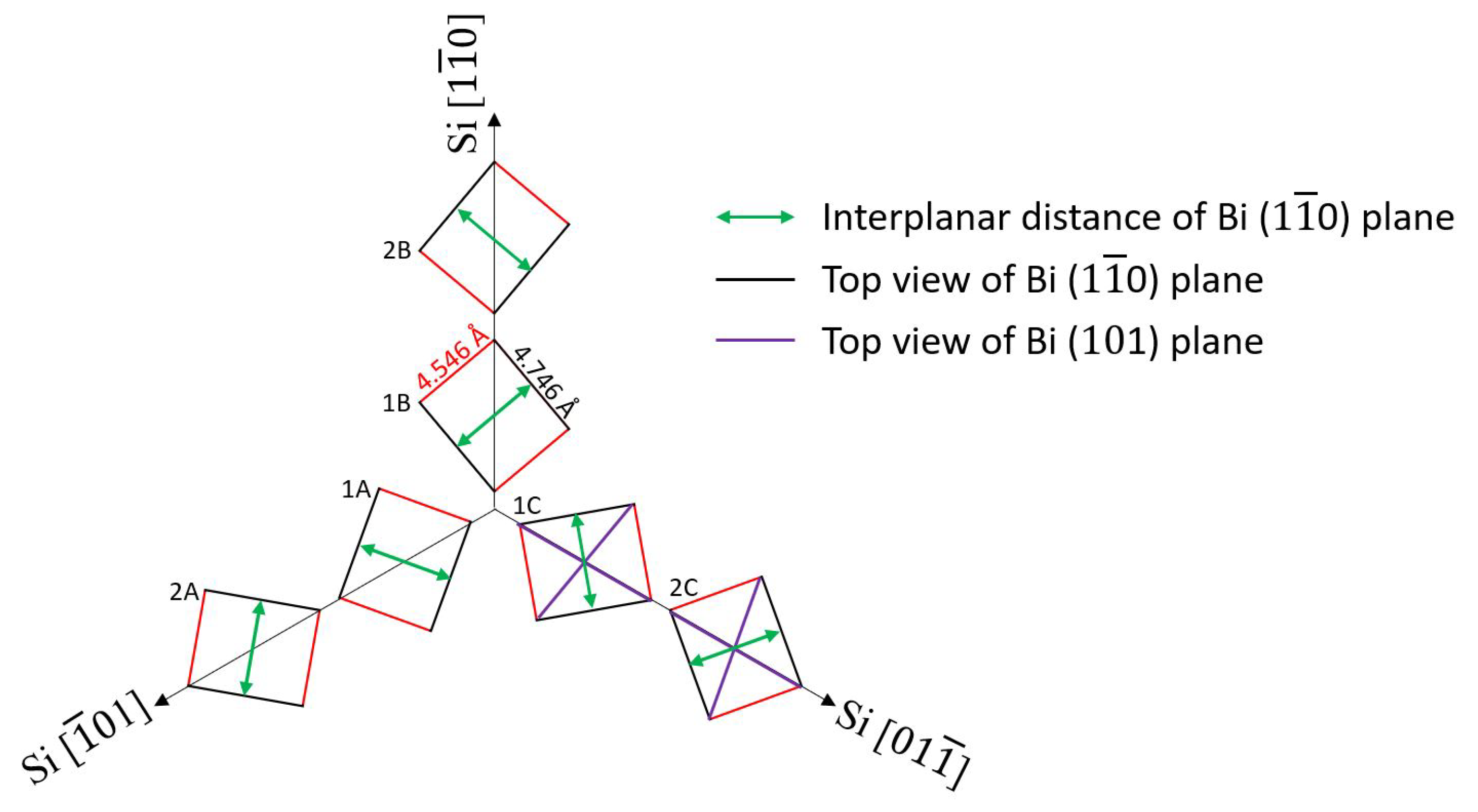
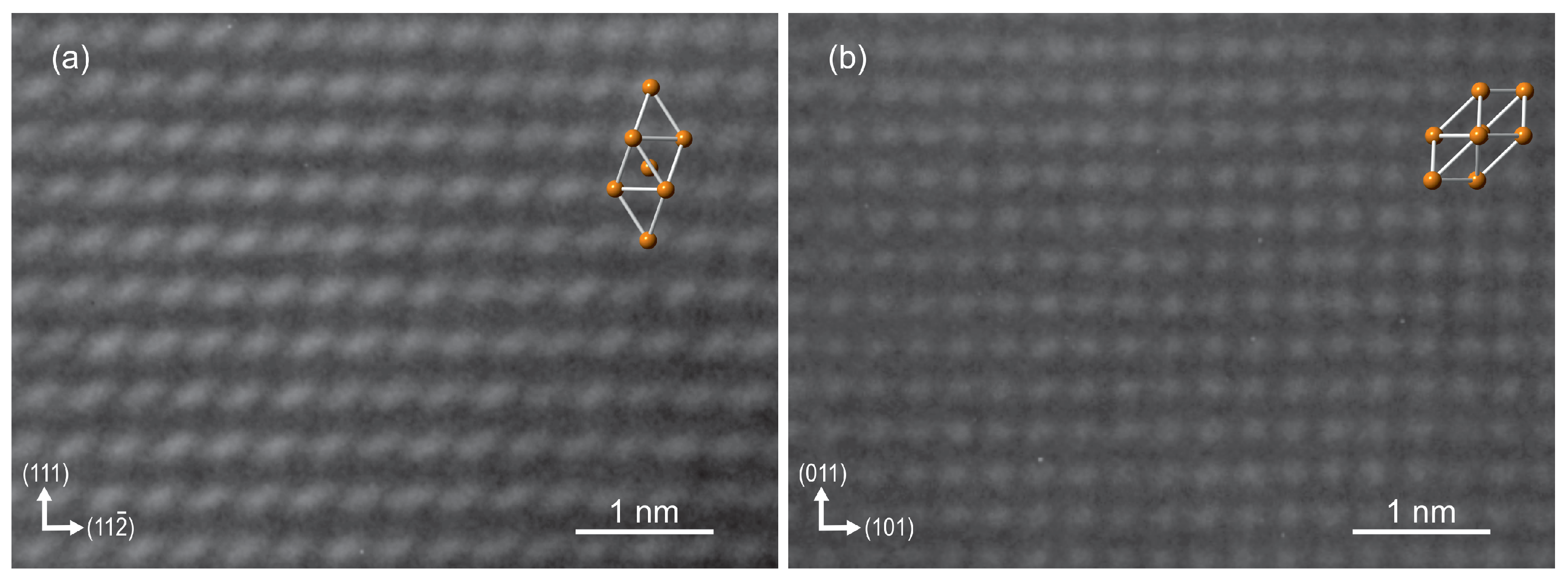
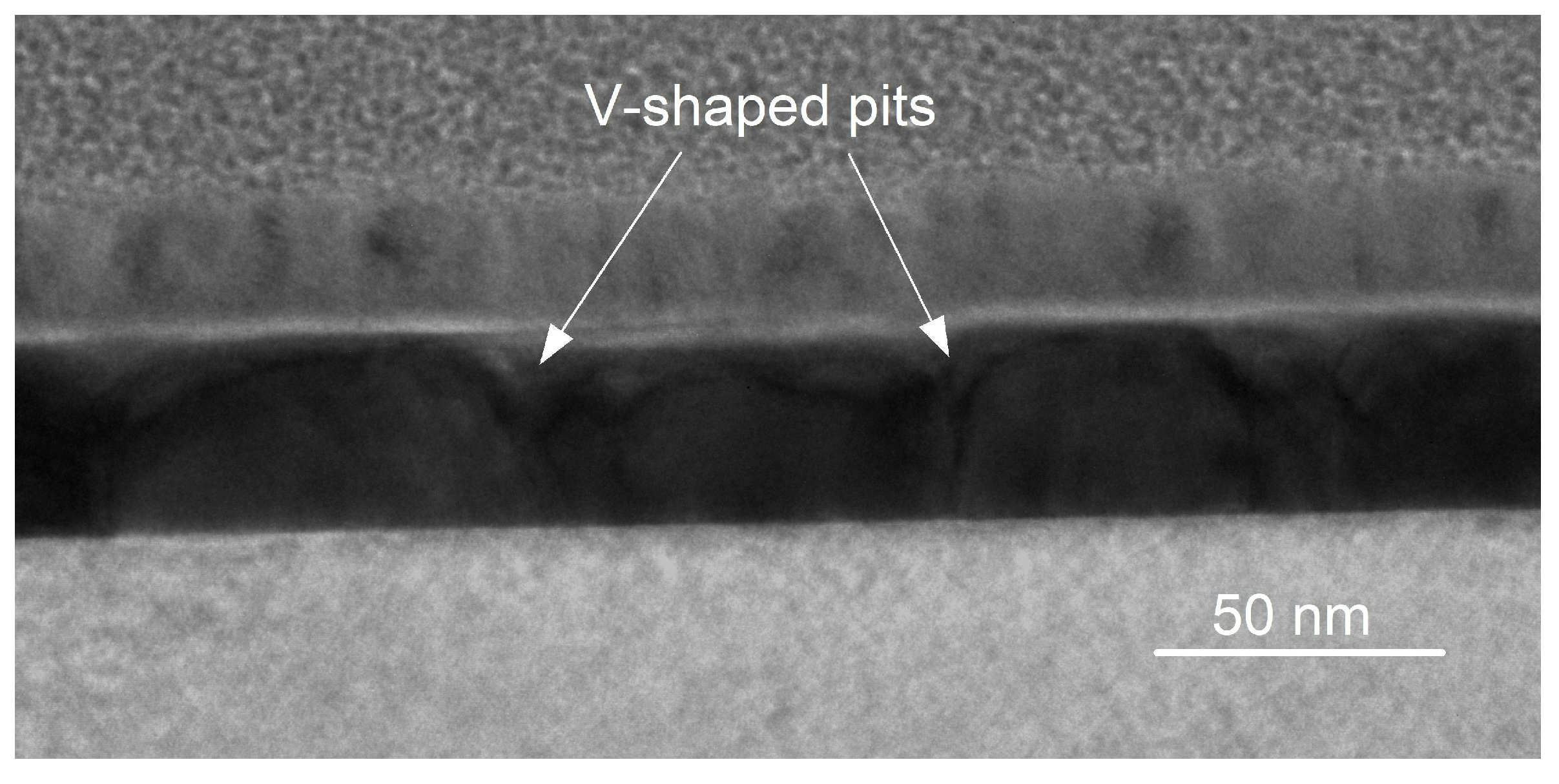
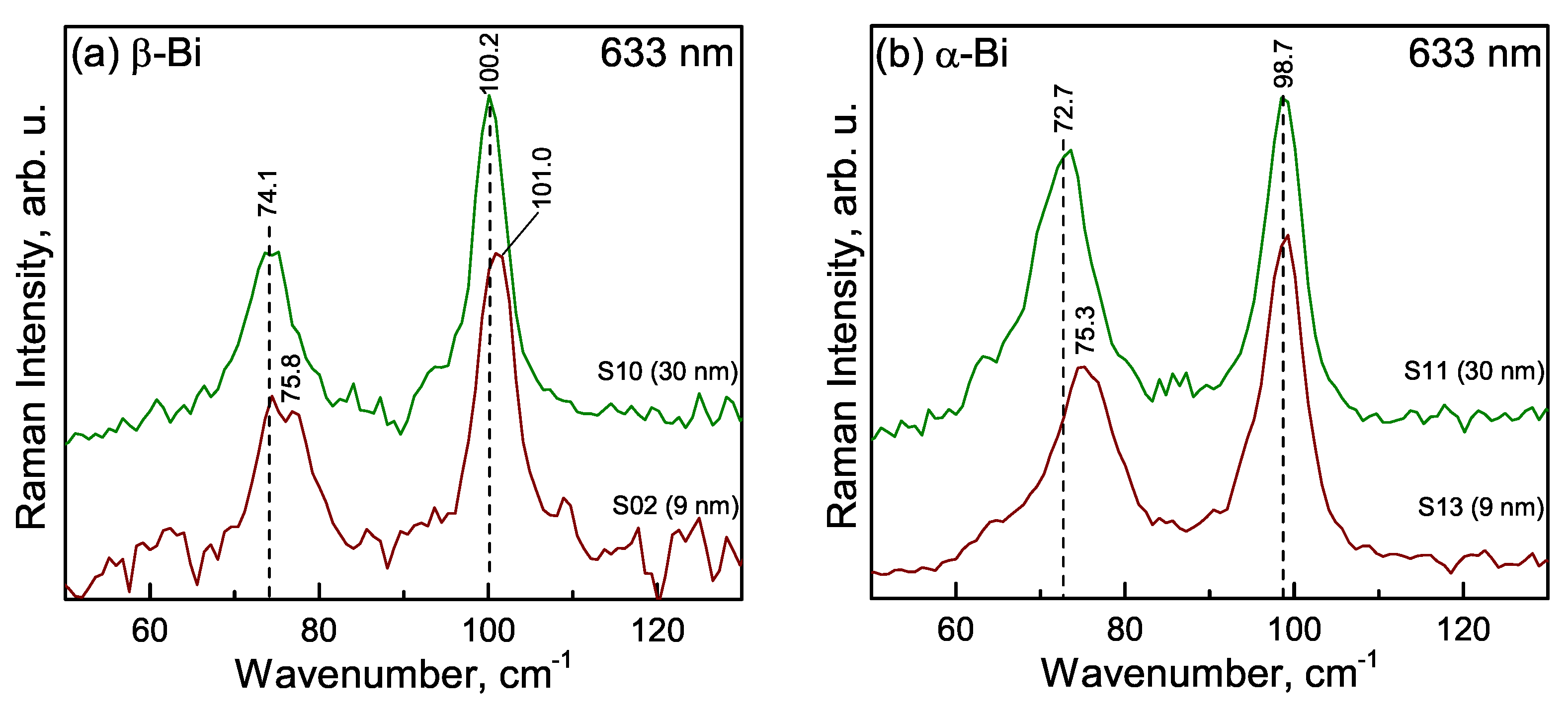
| Sample | Thickness, nm | Phase | Growth Temp., °C | Bi BEP, Torr | Growth Duration, s |
|---|---|---|---|---|---|
| S01 | 7.7 | -Bi | 100 | 7.58–8.09 × 10−8 | 706 |
| S02 | 8.8 | -Bi | 21 | 4.46–4.607 × 10−8 | 706 |
| S08 | 9.6 | -Bi | 50 | 5.764 × 10−8 | 1080 |
| S10 | 32.7 | -Bi | 50 ÷ 55 | 5.75 × 10−8 | 3940 |
| S06 | 5.8 | -Bi | −30 ÷ −15 | 1.8 × 10−8 | 2440 |
| S13 | 9.4 | -Bi | 50 | 7.8 × 10−8 | 900 |
| S12 | 18.9 | -Bi | 50 | 7.8 × 10−8 | 1870 |
| S11 | 27.8 | -Bi | 50 | 7.8 × 10−8 | 2700 |
| Sample | Strain Calculated from d(222) (zz), % | Strain Calculated from d(10) (xx), % | Strain Calculated from d(11) (yy), % |
|---|---|---|---|
| S01 | 0.82 | −0.69 | −0.63 |
| S02 | 0.75 | −0.69 | −0.65 |
| S08 | 0.76 | −0.66 | −0.65 |
| S10 | 0.52 | −0.54 | −0.51 |
| Sample | Strain Calculated from d(220) (zz), % | Strain Calculated from d(10) (xx), % |
|---|---|---|
| S13 | −1.26 | −0.96 |
| S12 | −0.34 | −0.54 |
| S11 | −0.13 | −0.39 |
| Sample | Raman Mode | , cm−1 | FWHM | AE1g/AA1g |
|---|---|---|---|---|
| S11 | Eg | 72.7 | 8.1 | 1.36 |
| A1g | 98.7 | 5.3 | ||
| S13 | Eg | 75.3 | 8.9 | 1.00 |
| A1g | 98.7 | 6.0 | ||
| S10 | Eg | 74.1 | 6.9 | 0.83 |
| A1g | 100.2 | 4.6 | ||
| S02 | Eg | 75.8 | 7.4 | 0.58 |
| A1g | 101.0 | 5.2 | ||
| Bulk Bi [10] | Eg | 69 | ||
| A1g | 94 |
Publisher’s Note: MDPI stays neutral with regard to jurisdictional claims in published maps and institutional affiliations. |
© 2022 by the authors. Licensee MDPI, Basel, Switzerland. This article is an open access article distributed under the terms and conditions of the Creative Commons Attribution (CC BY) license (https://creativecommons.org/licenses/by/4.0/).
Share and Cite
Stanionytė, S.; Malinauskas, T.; Niaura, G.; Skapas, M.; Devenson, J.; Krotkus, A. The Crystalline Structure of Thin Bismuth Layers Grown on Silicon (111) Substrates. Materials 2022, 15, 4847. https://doi.org/10.3390/ma15144847
Stanionytė S, Malinauskas T, Niaura G, Skapas M, Devenson J, Krotkus A. The Crystalline Structure of Thin Bismuth Layers Grown on Silicon (111) Substrates. Materials. 2022; 15(14):4847. https://doi.org/10.3390/ma15144847
Chicago/Turabian StyleStanionytė, Sandra, Tadas Malinauskas, Gediminas Niaura, Martynas Skapas, Jan Devenson, and Arūnas Krotkus. 2022. "The Crystalline Structure of Thin Bismuth Layers Grown on Silicon (111) Substrates" Materials 15, no. 14: 4847. https://doi.org/10.3390/ma15144847
APA StyleStanionytė, S., Malinauskas, T., Niaura, G., Skapas, M., Devenson, J., & Krotkus, A. (2022). The Crystalline Structure of Thin Bismuth Layers Grown on Silicon (111) Substrates. Materials, 15(14), 4847. https://doi.org/10.3390/ma15144847






